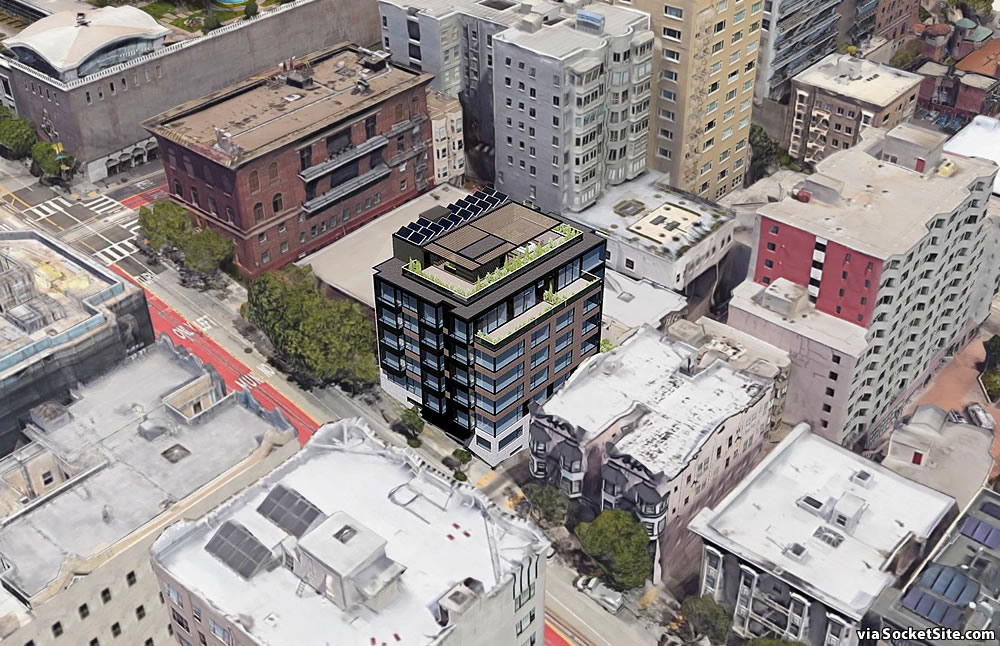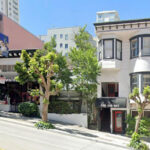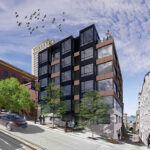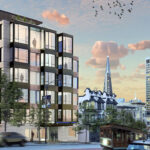As we outlined earlier this year, an application to entitle the development of a modern 7-story, 24-unit building upon the Nob Hill corner parcel currently occupied by two single-family homes, two apartments and the Twin’s Armoire building, a parcel which spans 842-860 California Street and back to 119 Joice, has been submitted to Planning.
The development as proposed would yield 22 market-rate condominiums and 2 market-rate rental units, with a total of 10 one-bedrooms, 12 twos and 2 threes; a basement garage for 8 cars and 26 bikes; and a rooftop terrace with built-in seating, a communal fire pit and an outdoor kitchen/grill with sweeping city views for the building’s residents.
And with the application to entitle the development having been formally accepted by Planning and now under review, the project site, which was acquired for $5.2 million in August of 2020, and plans have just been listed for $8.59 million, positioned as an opportunity to “hold and rent” the existing buildings on the project site, which are currently being held vacant, while seeking approval for the development or to “create a unique luxury compound.” We’ll keep you posted and plugged-in.





David Baker banal…….
The development as proposed and rendered above was designed by Cass Calder Smith, as previously reported and tagged.
it was a metaphor
So sad that that is replacing that.
Tearing down a garage or laundromat in this town causes all sort of insane ruckus. Will this face much pushback from the neighborhood? I would think these kind of buildings would actually be worth preserving.
Get over it… build with the future in mind.
Yes! Who gives a crap about history or uniqueness – about preserving the character of a city… Let’s bland-glass-box the planet. After all, look at Mission Bay or the Seaport District in Boston – drawing so many more tourists and local shoppers alike than those nasty old neighborhoods like Cow Hollow or Hayes Valley, or Back Bay and the North End.
I guess I’m officially curmudgeon, when I think of how much character this city has lost since I first moved here 30 years ago… and what passes for “progress” these days.
I don’t know anything about Boston, but if you’ve been here for 30 years, you know that 30 years ago Mission Bay was an empty rail yard and now it’s full of San Francisco residents plus world class medical research.
What is the problem here?
Mission Bay 2008: No reason to go there.
Mission Bay 2022: Every reason not to.
That’s what OP’s saying.
What about the people who live in Mission Bay? What about the people who conduct world class research there? What about people who attend a Warriors game? What about people who work at Benioff Children’s Hospital? What about people who want to check out the waterfront? (The parks are actually quite nice) What about the Spark Social place, which is packed with the youths?
It sounds like you personally have not been to Mission Bay. There are plenty of people who do go there, though.
The presence of some people there does not make Mission Bay a “success”, nor warrant using its drab suburban-scale office park theme to redevelop beautiful and vibrant neighborhoods elsewhere in the city.
In any event, if the measure is “full of residents” and “world class”, Nob Hill has had that in spaces for over a century – it hardly needs a bland glass box to leverage it forward.
I said nothing about the new building. I was responding to your comment that Mission Bay is not progress and that Mission Bay somehow cost San Francisco its character.
And I responded in kind about the *neighborhood* of Nob Hill. But this *article* is about a particular building proposal.
In any event, I’m sure that the gods of mediocrity are glad to have someone standing in defense of Mission Bay… I’ll stick to character, uniqueness and personality any day.
I can only observe all the people living in Mission Bay and all the world class research that is done there and the thousands of people who watch Warriors games there. It seems like progress to me, but probably the gods of vacant railyards are infuriated at all of it.
they paid $5.2M in 2020…and its worth maybe that much today.
It’s called a Hail Mary. Given today’s market my guess is they will have to settle for significantly less. Many of these projects are on the bubble when it comes to viability. Even projects such as this in upscale areas. Sutter recently put the entitlement for its massive [CPMC] residential development up for sale rather than build – that too is an upscale project.
put the “entitlement”…up for sale (still many years away from building permits)
No doubt the University Club will complain about losing its view, or at least a portion of it.
So spend 50k on plans and submit a planning application, then sell for 3.5 million more that you bought it for… these developers are geniuses!!! But wait there’s more!!! If you have just 10,000 dollars in your bank account you can be a developer too, all from the comfort of your home, just follow our 10 secret patented steps to make millions by doing absolutely nothing and you can turn your bum life into a chum life, trade your Camry for a Corvette, call now!
I completely get the sarcasm in this comment, but the “developers” have been sitting on the property, with the existing homes and apartments held vacant, for close to two years now. The $3.5M has to cover their holding and opportunity costs. Not that I think they’ll actually get that amount from a normal buyer.
Just leave the existing site alone. Thank you.
Herb Caen said it best (and I paraphrase): San Francisco was at its best the day we first arrived.
It’s difficult to overstate how much this sentiment impacts urban planning in the US.
I feel the same way about Hong Kong and Manhattan.
There is no evidence that this sentiment impacts urban planning anywhere in the US, including San Francisco.
Really? Coming from the person who is concerned about what a potential buyer might do to the _inside_ of one of the painted lady houses?
Yes. Those statements are not in conflict. Just because someone, or even many people, have a certain way of looking at individual properties, or real estate in general or the state of The City, doesn’t mean that evidence exists that this sentiment impacts urban planning in the The City, or in the U.S. in general in a meaningful way.
I realize that might be difficult to understand for someone who is in the business of selling real estate and whose personal pecuniary interests align with maximizing turnover and churn, and for whom there is never going to be enough change regardless of how it increases genericity and degrades The City’s sense of place and uniqueness for residents, but urban planners can and do ignore the sentiment of the general public, all the time.
You might be able to understand how little the opinions of long term residents matter when it comes to urban planning if you sat through a few Planning Commission meetings. Members of the Planning Commission can and do take large numbers of comments from the general public about a project or a general issue and then proceed to ignore them — routinely — when it comes time to make policy.
The reason that S.F. voters had to pass ballot measures such as Proposition M in the late eighties was precisely because in spite of sentiment that urban planning was going in a direction inconsistent with resident’s desires, planning was proceeding to align with the desires of people who were making it their business to proceed in the opposite direction (in that instance, commercial office developers).
As far as the Pink Painted Lady that is now up for sale, I can hope that a fipper won’t come along and buy it and turn it into a White Box Victorian, but just because I hold that opinion doesn’t mean that there exists any data backing up the claim that people who disapprove of white boxing exert significant sway over urban planning in the The City.
Your present and previously documented peculiar animus toward people in the real estate business speaks for itself.
We are in the midst of a policy pendulum swinging away from the hyper local control of planning (see most of Scott Wiener’s efforts over the past decade) and for good reason. If you want quantifiable data, I might start with the number of boomers at planning meetings who arrive in Priuses powered solely by smug self-righteousness.
We have a housing crisis in California because people who believe that “[insert city] was at its best the day we first arrived” prevent housing from being built. This is being recognized on both the right and the left.
You stay incensed, my bro. The world will change around you.
In terms of actual building and supply, at least locally, there are currently around 8,000 units of housing under construction in San Francisco. And while that’s around 10 percent fewer units under construction than a year ago, it’s still 10 percent more than average over the past decade with another 9,000 units that have been approved and permitted and another 9,000 entitled units for which building permits have been requested.
At the same time, the number of existing units for sale in San Francisco is up 40 percent year-over-year to an 11-year seasonal high.
That doesn’t sound like very much to me.
How do those numbers compare to change on population in California over the past thirty years. Are you saying we are building enough housing to make living here affordable? That affordability should be a primary goal for Planning purposes.
Feeding the fellows under the bridge,